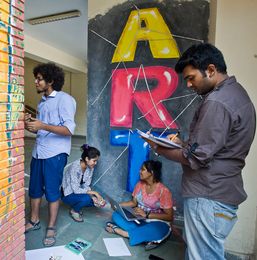I had the opportunity to attend the Art Education in India conference organised by the Foundation for Indian Art and Education (FIAE) and Goa University, this week. The conference had some of the most important artists and art educators in India speaking, including Gulammohammed Sheikh, Sadanand Menon, R. Siva Kumar, Indrapramit Roy and many others.
FIAE was formed out of the realisation that there did not exist a database that we could use to identify the problems of art education in India and the possible solutions for the future. So a number of researchers surveyed art colleges in India about the syllabi, infrastructure, students and funding. In 2015, the Kochi Biennale Foundation, at its Students’ Biennale conference, hosted the first report of the FIAE that covered the southern states. The Goa conference presented a more comprehensive data covering the whole of India.
My role at the conference was to present the lessons we have gathered through the Students’ Biennale, as well as my thoughts as an artist who has come through the Indian education system.
One of our learnings with the Students’ Biennale is about the disparity in conditions of art schools in India. The FIAE studies also bear this out. In Students’ Biennale workshops, we have attempted to bring together the students and resources of geographically close institutions, so that the students of one college can benefit from what is available at the other. Such an exchange and reciprocity between colleges could be activated at a larger scale.
Another lesson from the Students’ Biennale and our Young Residency programmes is that colleges are unable to connect students to the wider art-world ecosystem. I think an elementary layer of familiarisation with both the art-world landscape and its practices will be very useful for young artists. Simple exercises like how to prepare a portfolio, how to write a proposal will enable students to access opportunities that will otherwise remain distant from them. Art colleges should also create spaces where students can learn, read and talk about other subjects.
In spite of what we think is a surfeit of information available today, I find that many art students still do not have sufficient exposure to knowledge repositories on the internet or journals and magazines. One of the tasks of the teacher is to make sense of this bigness of data, to give students the tools to sort and filter information.
In addition, the presence of the teacher is important to ensure that she is not simply a compiler or a syllabus-giver. The teacher should enable the students to converse among themselves and with the world outside.
The most concerned discussions of the conference were on UGC policies, especially on qualifications of a teacher at colleges. It says that you have to have a PhD to get a job! Indian art has had many inspirational figures as teachers—Nandalal Bose, K.G. Subramanyan, A. Ramachandran and Gulammohammed Sheikh, to name a few. Sometimes, inspirational individuals outside institutions can also come to function like universities. At the conference, Sadanand Menon was talking about Akbar Padamsee, whose house in Mumbai was a gathering ground for filmmakers, artists and writers. I benefited tremendously from being able to meet and speak with such persons.
Finally, another element art schools have been unable to provide to students enough is the opportunity to travel. Young artists should be able to travel to different places, especially to visit museums, biennales and galleries. These should be included in the syllabi, and museums and other such institutions should take a proactive role in facilitating visits from art schools.
editor@theweek.in


